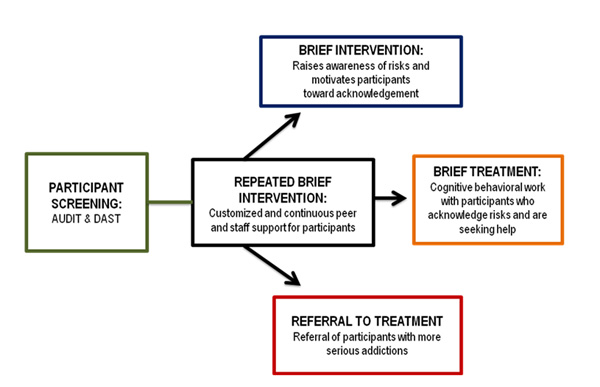DOL and HHS Work Together to Address Youth Substance Use
Collaboration Structure
Learn more about the structure of the pilot program and the partnership between the Department of Health and Human Services’ Substance Abuse and Mental Health Services Administration (SAMHSA) and Department of Labor’s Employment and Training Administration (ETA).
Interagency Working Group on Youth Programs (IWGYP) brings agency efforts together
Both SAMHSA and ETA are members of the IWGYP. Through the relationships built within the working group and the information sharing between agencies within the IWGYP, SAMHSA and ETA were able to identify and address an issue that was common to both agencies, the effect of substance abuse on employment and employability. As a result they recognized how the Screening, Brief Intervention, and Referral to Treatment model (SBIRT), developed by SAMHSA, could be implemented within ETA’s YouthBuild programs to help address the challenge of alcohol and drug use among YouthBuild participants and clarify the relationship between substance use, experimentation, and abuse and employment outcomes.
Agency leadership at both SAMSHA and ETA designated staff members to carry out the work of the pilot program. These staff members worked closely together throughout the project. They participated in interactive conference calls, held face-to-face meetings, coordinated the model development and training, and conducted presentations at SAMHSA and ETA to share the results of the pilot program.
Fifteen geographically diverse ETA-funded YouthBuild programs were selected to participate in the pilot project. Prescreening calls and baseline organizational assessments were used to get a sense of the need, interest, and capacity of programs. Program performance was reviewed to assess the capacity of programs to add the SBIRT model to their programs without detracting from the work they were currently doing.
The following YouthBuild programs participated in the YouthBuild SBIRT pilot:
- HoustonWorks; Houston, TX
- Education Services District 101; Spokane, WA
- La Fe Community Development Center; El Paso, TX
- Century Center for Economic Opportunity; Lennox, CA
- Comprehensive Community Solutions; Rockford, IL
- Workforce Connections; La Crosse, WI
- YMCA Old Colony; Brockton, MA
- Waukesha-Ozaukee-Washington WDB; Pewaukee, WI
- Alachua-Florida Institute for Workforce Innovation; Melrose, FL
- Sacramento Local Conservation Corps; Sacramento, CA
- Prevention Plus, Inc.; Forest Park, GA
- Chicago Southland, OAI; Harvey, IL
- WorkNet Pinellas, Inc.; Clearwater, FL
- Lummi Housing Authority; Bellingham, WA
- Tohatchi Area of Opportunity & Services; Tohatchi, NM
SAMSHA and ETA adapted SBIRT structure to fit YouthBuild context
The SBIRT is a clinical model originally designed for health-related settings by SAMHSA. For use in the pilot project, the SBIRT model needed to be adapted to best suit the young people, ages 16 to 24, served within the YouthBuild program. ETA and SAMHSA staff worked together to adapt the model and define the components of the SBIRT in the context of YouthBuild while maintaining the integrity of the model. The figure below provides a graphic illustrating the adapted model.

Programs could choose to use one of two screening tools, Alcohol Use Disorders Identification Test (AUDIT) or Drug Abuse Screening Test (DAST), or implement both screeners. Based on the results of the screening tool, participants may require no intervention, brief intervention, brief repeated interventions, brief treatment, or referral to more intensive treatment. Pilot sites were provided training and technical assistance by SAMHSA and ETA about the SBIRT model as well as the implementation process. Learn more about the technical assistance and training involved in the collaboration.
